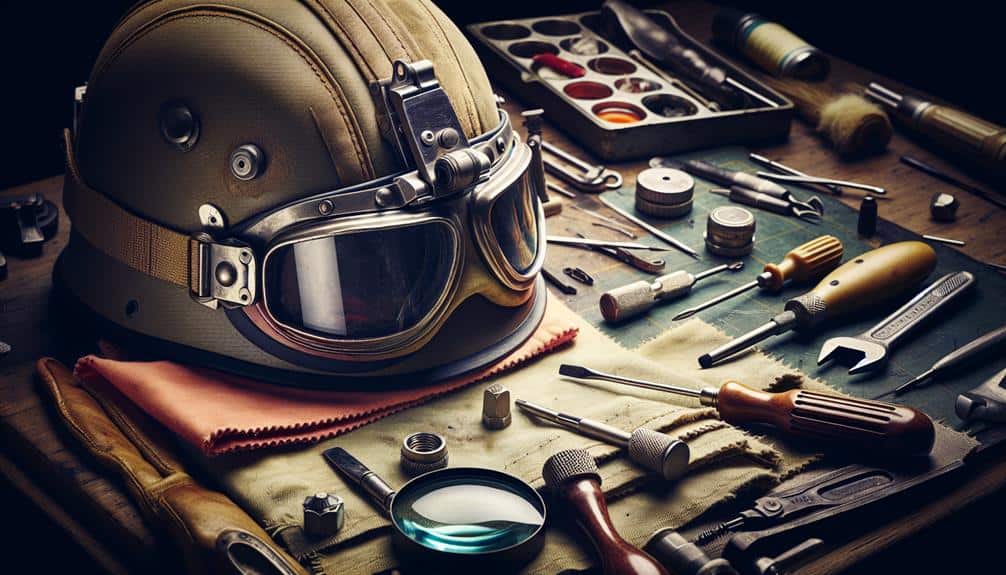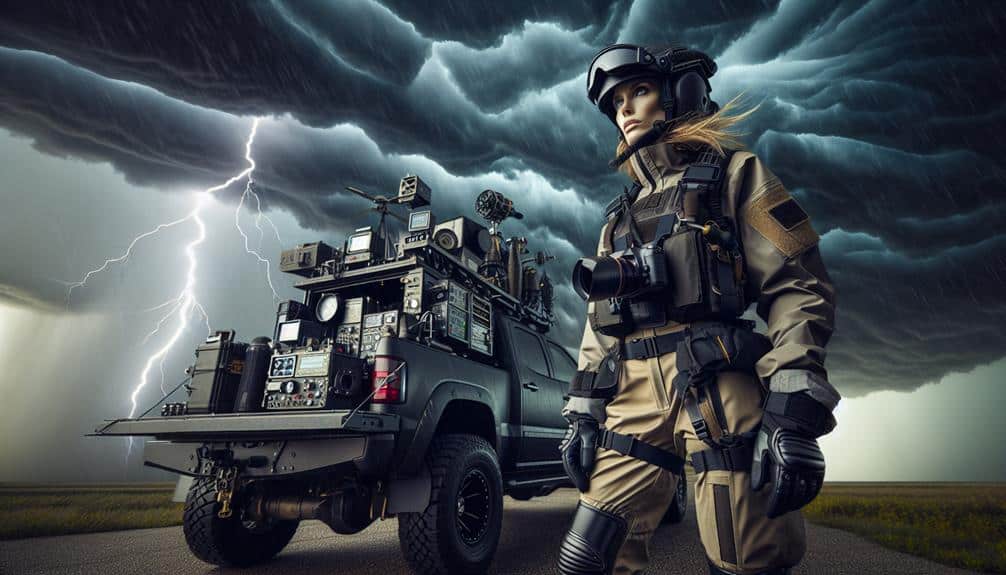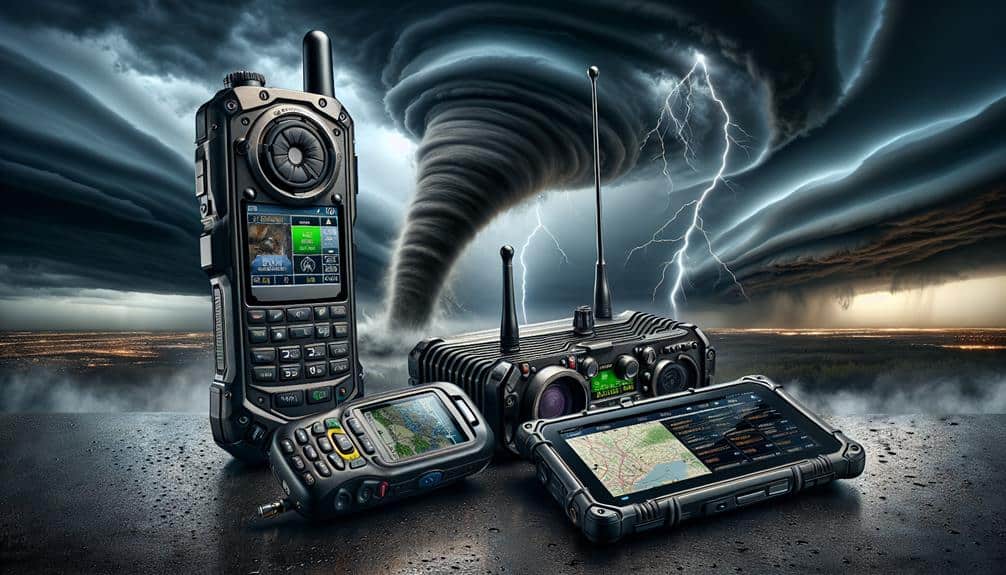Let's prioritize our storm chaser headgear protection with these top tips: First, ensure impact resistance with polycarbonate or advanced composites meeting ANSI and ASTM standards. Second, a proper fit is essential—use comfortable padding and secure chin straps for stability. Third, opt for lightweight, breathable materials to prevent overheating. Fourth, account for weather elements with ventilation and reflective elements for visibility. Finally, maintain and inspect our headgear regularly, checking for integrity and functionality of all components. With these guidelines in place, our headgear will provide best protection and comfort, enhancing our safety during storm chases. For more in-depth details, stay tuned.
Key Points
- Prioritize impact-resistant materials like polycarbonate and advanced composites to protect against airborne debris.
- Ensure a proper fit with comfortable padding, secure chin straps, and customized adjustments for optimal protection.
- Opt for lightweight, breathable designs to enhance mobility, prevent overheating, and maintain cognitive functions.
- Consider weather elements and choose headgear with adjustable ventilation slots and moisture-wicking liners to stay comfortable.
Prioritize Impact Resistance
When crafting storm chaser headgear, we must prioritize impact resilience to ensure maximum protection against airborne debris and severe weather conditions. This necessitates us to carefully choose materials that enhance helmet durability, such as polycarbonate and advanced composites, which can withstand high-velocity impacts without compromising the integrity of the headgear.
Our headgear should meet or exceed rigorous safety standards, like those established by ANSI (American National Standards Institute) and ASTM (American Society for Testing and Materials). By adhering to these benchmarks, we guarantee that our helmets provide strong protective capabilities, minimizing the risk of head injuries in turbulent environments.
Additionally, integrating multi-layered construction techniques can significantly enhance impact resilience. For example, a combination of a tough outer shell and an energy-absorbing inner liner can effectively distribute the force of an impact, reducing the chances of trauma.
We also need to take into account the aerodynamic design to lessen drag and potential wind resistance, which can cause added strain during storm chasing activities. By focusing on these technical aspects, we not only improve helmet durability but also align with established safety standards, empowering storm chasers to operate freely and confidently in extreme conditions.
Ensure Proper Fit
How do we ensure our storm chaser headgear fits properly to maximize both comfort and safety?
First, we need to focus on proper alignment. A correctly aligned helmet guarantees the best distribution of impact forces, minimizing potential injury. To achieve this, we should adjust the headgear so that the front edge rests just above our eyebrows, providing an unobstructed field of view while safeguarding our forehead.
Next, let's turn our attention to the internal components, particularly comfortable padding. High-quality padding not only enhances comfort but also plays an essential role in absorbing shock. We should look for headgear with adjustable padding systems, allowing us to customize the fit to the unique contours of our heads. This customization is vital for maintaining stability during high-wind scenarios characteristic of storm chasing.
Additionally, we mustn't overlook the importance of a secure chin strap. The strap should be tight enough to keep the helmet in place but not so tight that it causes discomfort or restricts movement. A properly fitted chin strap ensures that the helmet remains securely on our heads, even in the most turbulent conditions.
Opt for Lightweight Materials
After ensuring a snug fit, we should prioritize headgear made from lightweight materials to reduce fatigue and enhance mobility during extended storm chasing sessions. Lightweight materials, such as polycarbonate or advanced composites, are vital for minimizing the strain on our necks and shoulders. This reduction in weight translates directly to increased stamina and reaction time, essential factors when maneuvering unpredictable storm environments.
In addition to weight considerations, selecting headgear with a breathable design is crucial. Proper ventilation prevents overheating, which can impair our cognitive functions and decision-making abilities. Mesh panels or strategically placed vents can significantly enhance airflow, keeping us cool and focused.
Adjustable straps are another key feature to look for in lightweight headgear. They allow us to customize the fit, ensuring stability and comfort even during high-wind situations. Adjustable straps also offer the flexibility to wear additional protective gear, such as goggles or communication devices, without compromising the headgear's fit or function.
Consider Weather Elements
We must account for various weather elements, such as rain, hail, and high winds, that can greatly impact the effectiveness and durability of our headgear. By considering these factors, we guarantee that our gear offers top-notch protection and longevity.
Weather durability is a critical factor; our headgear must withstand intense conditions without compromising safety or functionality. Materials like high-density polyethylene and polycarbonate are excellent choices due to their resilience against impact and weather elements.
Comfort and breathability are equally important. During high-intensity chases, our headgear must provide adequate ventilation to prevent overheating and discomfort. Features like adjustable ventilation slots and moisture-wicking liners can notably enhance comfort, ensuring that we remain focused on the storm rather than our gear.
Style might seem secondary, but it plays a role in user satisfaction and confidence. A streamlined design with a secure fit can improve aerodynamics, reducing wind resistance and making the headgear more comfortable to wear for extended periods. Additionally, reflective elements can boost visibility in low-light conditions, adding an extra layer of safety.
Regular Maintenance and Inspection

Maintaining our headgear's effectiveness and reliability necessitates a rigorous schedule of regular maintenance and inspection. We can't afford to compromise on helmet durability, especially when we're up against extreme weather conditions. To maximize protection, we should adopt a proactive inspection schedule—preferably every month or after each storm-chasing expedition.
First, we need to inspect the helmet shell for any cracks, dents, or deformities. Even minor imperfections can compromise its structural integrity. Don't forget to check the inner lining for wear and tear; a degraded lining could reduce impact absorption. Confirm the chin strap's functionality and make certain it hasn't frayed or loosened over time.
Next, we should clean our helmets using a mild, non-abrasive cleaner. Avoid harsh chemicals that could weaken the materials. Maintaining cleanliness not only prolongs helmet durability but also guarantees visibility of any hidden damages.
Frequently Asked Questions
What Are the Best Brands for Storm Chaser Headgear?
Selecting reputable helmet brands such as POC and Bell guarantees durability for storm chasers. These helmets provide advanced safety features like MIPS technology and robust shell construction, offering both protection and freedom during intense weather conditions.
Can I Use Motorcycle Helmets for Storm Chasing?
We can use motorcycle helmets for storm chasing if we verify helmet compatibility with our gear. These helmets often have strong safety features like impact resistance and face shields, which can provide effective protection in severe weather conditions.
How Do I Customize My Headgear for Better Comfort?
Comfort is essential. Begin with customization techniques such as incorporating memory foam padding and moisture-wicking liners. These comfort enhancements guarantee a secure fit, minimizing pressure points and keeping us cool and focused during our storm chasing escapades.
Are There Any Budget-Friendly Options for Storm Chaser Headgear?
We can explore budget-friendly alternatives by considering DIY modifications. Using materials like hard hats and weather-resistant fabrics, we can create efficient, low-cost headgear. This approach guarantees safety and comfort without compromising our freedom to chase storms.
How Can I Integrate Communication Devices Into My Headgear?
To integrate communication devices into our headgear, we can make helmet modifications like drilling mount points or adding brackets. We'll guarantee weatherproof communication by using waterproof cases and sealing all entry points with silicone to prevent moisture.


